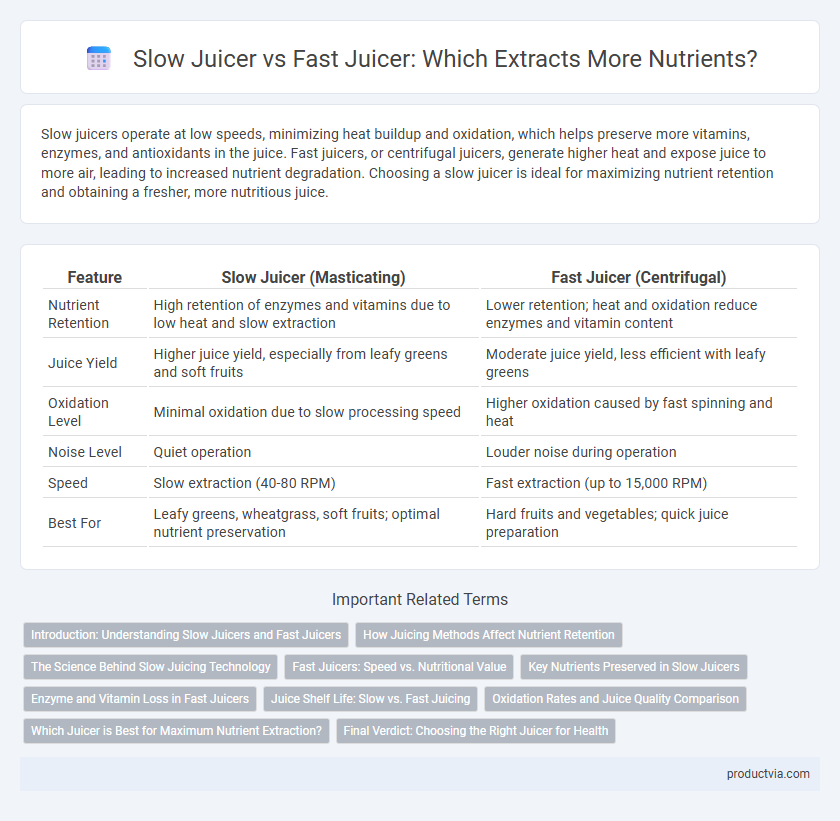Slow juicers operate at low speeds, minimizing heat buildup and oxidation, which helps preserve more vitamins, enzymes, and antioxidants in the juice. Fast juicers, or centrifugal juicers, generate higher heat and expose juice to more air, leading to increased nutrient degradation. Choosing a slow juicer is ideal for maximizing nutrient retention and obtaining a fresher, more nutritious juice.
Table of Comparison
| Feature | Slow Juicer (Masticating) | Fast Juicer (Centrifugal) |
|---|---|---|
| Nutrient Retention | High retention of enzymes and vitamins due to low heat and slow extraction | Lower retention; heat and oxidation reduce enzymes and vitamin content |
| Juice Yield | Higher juice yield, especially from leafy greens and soft fruits | Moderate juice yield, less efficient with leafy greens |
| Oxidation Level | Minimal oxidation due to slow processing speed | Higher oxidation caused by fast spinning and heat |
| Noise Level | Quiet operation | Louder noise during operation |
| Speed | Slow extraction (40-80 RPM) | Fast extraction (up to 15,000 RPM) |
| Best For | Leafy greens, wheatgrass, soft fruits; optimal nutrient preservation | Hard fruits and vegetables; quick juice preparation |
Introduction: Understanding Slow Juicers and Fast Juicers
Slow juicers, also known as masticating juicers, operate at low speeds to minimize heat and oxidation, preserving higher levels of nutrients and enzymes in fruits and vegetables. Fast juicers, or centrifugal juicers, use high-speed spinning blades that generate heat and expose juice to more air, potentially reducing nutrient retention. Choosing between these juicers affects the quality and health benefits of fresh juice, with slow juicers generally offering superior nutrient preservation.
How Juicing Methods Affect Nutrient Retention
Slow juicers use cold-press technology, minimizing heat and oxidation to preserve higher levels of vitamins, enzymes, and antioxidants in the juice. Fast juicers, relying on high-speed spinning blades, generate heat and introduce more air, which can degrade sensitive nutrients and reduce overall nutrient retention. Studies show slow juicing methods retain up to 20-30% more nutrients compared to fast juicers, making them preferable for maximizing health benefits.
The Science Behind Slow Juicing Technology
Slow juicers operate using a cold-press mechanism that slowly crushes and squeezes fruits and vegetables, minimizing heat and oxidation, which preserves delicate enzymes, vitamins, and antioxidants. The reduced speed and absence of high heat generation prevent nutrient degradation that typically occurs in fast juicers using high-speed spinning blades. Scientific studies confirm that slow juicing retains higher levels of phytonutrients and enzymes essential for optimal health benefits compared to fast juicing methods.
Fast Juicers: Speed vs. Nutritional Value
Fast juicers operate at high speeds, rapidly extracting juice but generating heat that can degrade sensitive nutrients like enzymes and vitamins. While their efficiency benefits users seeking quick juice preparation, the elevated speed may result in lower retention of antioxidants compared to slow juicers. Choosing between fast and slow juicers depends on balancing the need for speed against maximizing nutritional value in freshly extracted juice.
Key Nutrients Preserved in Slow Juicers
Slow juicers, also known as masticating juicers, excel at preserving key nutrients such as vitamins C and A, enzymes, and antioxidants due to their low-speed extraction process, which minimizes heat and oxidation. These juicers effectively retain phytonutrients like flavonoids and polyphenols, critical for boosting immune function and reducing inflammation. The gentle pressing mechanism ensures higher preservation of chlorophyll and trace minerals compared to fast centrifugal juicers, making slow juicers superior for nutrient-dense juice extraction.
Enzyme and Vitamin Loss in Fast Juicers
Slow juicers operate at low speeds, minimizing heat generation and oxidation, which helps preserve delicate enzymes and vitamins such as vitamin C and B-complex. Fast juicers use high-speed spinning blades that generate heat and exposure to air, accelerating nutrient degradation and significantly reducing enzyme activity. Studies show that slow juicers retain up to 40% more nutrients compared to fast juicers, making them superior for nutrient retention in fresh juices.
Juice Shelf Life: Slow vs. Fast Juicing
Slow juicers preserve nutrients by minimizing heat and oxidation during extraction, resulting in juice with a longer shelf life, typically lasting 48 to 72 hours when refrigerated. Fast juicers, or centrifugal juicers, generate more heat and introduce more air, accelerating nutrient degradation and reducing juice freshness to about 24 hours. Choosing a slow juicer ensures maximum nutrient retention and extended juice freshness, making it ideal for nutrient-focused consumers.
Oxidation Rates and Juice Quality Comparison
Slow juicers operate at lower RPMs, significantly reducing oxidation rates and preserving higher levels of vitamins, enzymes, and antioxidants in the juice. Fast juicers, while efficient in speed, generate more heat and air incorporation, leading to quicker nutrient degradation and foam formation. Consequently, slow juicers produce clearer, nutrient-rich juice with extended shelf life, whereas fast juicers yield juice that oxidizes faster and may lose nutritional value more rapidly.
Which Juicer is Best for Maximum Nutrient Extraction?
Slow juicers, also known as masticating juicers, operate at low speeds to minimize heat and oxidation, preserving more vitamins, enzymes, and antioxidants in the juice. Fast juicers, or centrifugal juicers, use high-speed blades that generate heat, potentially degrading some sensitive nutrients and reducing overall nutrient retention. For maximum nutrient extraction, slow juicers are generally considered the best option due to their gentle extraction process that retains higher levels of nutrients and prolongs juice freshness.
Final Verdict: Choosing the Right Juicer for Health
Slow juicers, also known as masticating juicers, typically preserve more nutrients and enzymes due to their low-speed extraction process, which minimizes heat and oxidation. Fast juicers, or centrifugal juicers, operate at high speeds, producing juice quickly but often compromising nutrient retention and causing more foam and oxidation. For optimal health benefits, a slow juicer is generally the better choice because it retains higher levels of vitamins, antioxidants, and enzymes essential for nutrient absorption.
Slow juicer vs Fast juicer for nutrient retention Infographic

 productvia.com
productvia.com